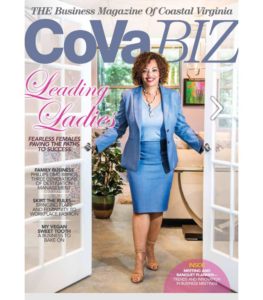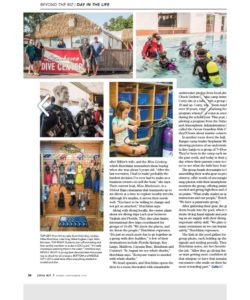Dive Right In
Lynnhaven Dive Center Introduces Customers To An Underwater World Through Scuba, Snorkeling And Swimming
With its roof covered in palm thatch and a storefront adorned with tiki columns, Lynnhaven Dive Center stands out among other businesses on North Great Neck Road. Lindsey Hillier-Hotchkiss emerges from the glass doors, rolling a rack of wetsuits outside. Inside, customers browse an assortment of diving and snorkeling gear, T-shirts, flip flops and other apparel, sunscreen and more.
“I love showing people all the beautiful stuff that’s underwater,” Hotchkiss remarks as she references a display of underwater photography gear. Having completed over 1,000 dives in her lifetime, it’s safe to say that she’s familiar with the underwater world. Her ownership of the business seems like a natural fit, although it wasn’t a planned one. “I had two older brothers, and my dad always kind of groomed them to take it over,” she remembers.
Her father, Mike Hillier, founded Lynnhaven Dive Center (now shortened to LDC) in 1977. A former marine biology teacher, he had fallen in love with diving and set out, with his wife, in search of the perfect place to open a dive center. They traveled up and down the East Coast and finally settled on Virginia Beach as an ideal location.
Hotchkiss had no intention of taking over the business and instead started her career as a trauma nurse. But then her dad was diagnosed with stage 4 cancer with a prognosis of six months to live. “We all just shook our lives apart,” she explains. Her family considered selling the dive shop, but her attachment to the business changed those plans. “We all grew up with this huge passion for diving,” Hotchkiss says. “I wanted my kids to grow up here and do all the same things. So I left my career and came here.”
Now, 12 years later, her dad is cancer-free, and Hotchkiss is in a career that makes her happy. “I still feel like I’m helping people in a way,” she says. “People are dealing with all the stress of their lives, and they do diving, and it takes them away from everything.”
She owns the business with her husband, Scott. Today, he’s sitting at a desk working at his computer. A solid white cat, Barnacle, happily paces around his office, lending to the convivial and easygoing atmosphere of the business. The couple met through diving (naturally) when Lindsey hired Scott to work at the center. They have four children, ages ranging from 3 to 20, and they spend a lot of time together on the water—or, rather, underneath it.
The center employs about a dozen people year-round. During summer, their busiest season, an additional dozen or so come on board to instruct scuba and swim lessons. A heated indoor pool allows them to continue instruction year-round, with swimming classes starting as early as 6 months, snorkeling for ages 5 and up and Scuba Rangers for ages 7–10.
Hotchkiss instructs swimming classes on occasion, but most of her time is spent keeping up with the many facets of the business—the charter boat they run, swimming and scuba classes they offer, summer camps for young divers, regional and international scuba excursions, as well as day-to-day tasks such as bills, scheduling, marketing and running the website.
Along with the retail portion of the business, they sell scuba equipment for government/commercial use, and they operate an equipment service center. Blake Hughes is the service department manager and has been servicing equipment at LDC since 2001. “When Lindsey’s dad opened the shop, he sold so much equipment and kept such a good reputation up that I still fix things that are 20–30 years old,” Hughes says. Hotchkiss concurs, “It’s the reputation that my dad built when he started here and all the relationships he made.”
LDC has owned several dive boats in its business history like the Cindy Loo, named after Hillier’s wife, and the Miss Lindsey, which Hotchkiss remembers them buying when she was about 5 years old. “After the last recession, I had to make probably the hardest decision I’ve ever had to make as a business owner—to sell the boat,” she says. Their current boat, Miss Mackenzie, is a 34-foot Baja catamaran that transports up to six divers at a time to explore nearby wrecks. Although it’s smaller, it serves their needs well. “You have to be willing to change and not get so attached,” Hotchkiss says.
Along with diving locally, the center plans about six diving trips each year between Virginia and Florida. They also plan larger, international dive trips coordinated for groups of 15–60. “We know the places, and we know the people,” Hotchkiss expresses. “It’s just so much more fun to go together as a group with dive buddies.” A few of their destinations include Florida Springs, Key Largo, Maldives, Cayman Brac, Honduras and Cozumel. “In August we see whale sharks,” Hotchkiss says. “Everyone wants to snorkel with whale sharks.”
We head upstairs, and Hotchkiss opens the door to a room decorated with remarkable underwater photos from local photographer Chuck Guthrie. Scuba camp instructor Greg Curry sits at a table with a group of kids ages 10 and up. Curry, who’s been teaching for over 20 years, runs a year-long Scuba Squad program where kids come in once a month during the school year. This year, the group is piloting a program from the National Oceanic and Atmospheric Administration (NOAA) called the Ocean Guardian Kids Club, where they’ll learn about marine conservation.
In another room down the hall, Scuba Ranger camp leader Stephanie McKinney is showing pictures of an underwater habitat in Key Largo to a group of 7–10-year-olds. They’ve been in the camp each morning for the past week, and today is their graduation day where their parents come to the dive center to see what the kids have learned.
The group heads downstairs to begin assembling their scuba gear as proud parents observe, offer words of encouragement and snap photos with their smartphones. McKinney monitors the group, offering assistance when needed and giving high-fives and elbow bumps as praise. “What really makes us special is our instructors and our people,” Hotchkiss says. “We have a passionate group.”
After gathering their gear, the group of students heads into the pool, where they demonstrate diving hand signals and practice sharing an air supply with their diving buddy, an important safety skill. “We plan on getting as many swimmers as we can learning to swim safely,” Hotchkiss expresses.
The kids in the pool gather for a final group photo, each holding up their OK hand signals and smiling proudly. These smiles, Hotchkiss notes, are her favorite aspect of the job. “After they go diving the first time or start getting more confident diving or see that stingray or have that amazing animal encounter—the smile on their face is the most rewarding part.”
Story and Photos By Angela Blue




